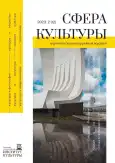Том 4, № 2 (2023)
- Год: 2023
- Выпуск опубликован: 25.07.2023
- Статей: 10
- URL: https://journals.eco-vector.com/2713-301X/issue/view/7895
Весь выпуск
Культура и философия
Звуковой код культуры: феномен тишины
Аннотация
Тишина исследуется автором в культурфилософском ракурсе как часть звукового кода культуры, самодостаточное явление, которое пересекается, но не совпадает с другими формами звукового кода (вербальным и музыкальным). Полифункциональность звукового кода обнаруживается в единстве смысла и звука, а также во включенности человеческого голоса в определенную культуру как целостную систему. Тишина выступает и точкой, и границей взаимодействия бытия мира и человека. С одной стороны, она является характеристикой бытия, с другой – символом присутствия в нём человека, который способен воспринимать и переживать тишину. Специфика феномена тишины заключается в том, что данная часть звукового кода культуры способна создавать и развивать свой семантический код, тем самым открывая человеку возможность не только для восприятия, но и для трансляции бытия.
 13-19
13-19


Культура и общество
Роль гендерного дискурса в конструировании «признанного субъекта» молодежной субкультуры граффити
Аннотация
В современном мире мы наблюдаем беспрецедентные изменения в гендерных темах. На этом фоне встает вопрос о степени таких трансформаций в молодежных субкультурах. В данной статье рассматривается молодежная субкультура граффити, знаковой чертой которой является маскулинность. Результаты исследования показывают, что биологический пол граффитчика все меньше влияет на оценку качества его работы, что позволяет девушкам войти в публичное поле граффити. Тем не менее маскулинность остается для этой субкультуры основой идентичности.
 23-31
23-31


Культура и искусство
Режиссерские стратегии Анатолия Праудина в интерпретации классики
Аннотация
Спектакли Анатолия Праудина, поставленные в Самарском театре юного зрителя «СамАрт» в 2000 – 20-х гг., основаны на текстах классических произведений – пьесах У. Шекспира, А.Н. Островского, А.П. Чехова, прозе Л.Н. Толстого, А.П. Чехова, И.А. Бунина. Разные авторы, тексты разных эпох требуют, несомненно, разных подходов к созданию их сценических версий.. Однако при всем различии спектакли Анатолия Праудина имеют много общего в использовании постановочных приемов, в характерной для его режиссуры знаковой системе. Подробный анализ спектаклей, представленный в статье, позволяет выявить своеобразие режиссерской стратегии Праудина и сформулировать концепцию его творчества, что и составляет цель данной работы.
 35-47
35-47


Новая театральность в эпоху медиатизации
Аннотация
Центральной проблемой настоящего исследования, посвященного медиаформатам постдраматических спектаклей, становится вопрос о трансформации театральности как публичной практики, ее переходе в персональную практику индивида на основе механизмов интерактивности, перформативности и иммерсивности. Автор оценивает влияние медиатизации общественной и приватной жизни человека на формирование новой театральности, опирающейся не на со-бытие и не на со-участие, а на со-знание собственного Я.
 48-56
48-56


Сотворческий полилог: искусствоведческий аспект
Аннотация
Музыкант раскрывается как уникальная творческая личность в диалогическом пространстве музыкального сотворчества. Образующиеся диалогические связи между сонаправленными участниками обладают чрезвычайно широким и проникающим спектром воздействия на разных уровнях интерактивного информативного и экзистенциального взаимодействия. В статье на практических примерах анализируются особенности сотворческого полилога в зависимости от уровней и характера протекания диалогических связей в музыкальной коммуникации.
 57-70
57-70


Книжная культура
Культурологический вектор исследований в документно-коммуникационных науках: возможности и перспективы
Аннотация
Автор рассматривает возможности культурологического изучения проблематики документно-коммуникационных наук по двум направлениям: предметному и аспектному. В исследовании приводятся примеры культурологических интерпретаций ряда базовых понятий. Раскрываются особенности культурологического метода и сущностные основания библиографической культуры, книжной культуры, информационной культуры и медиакультуры.
 73-82
73-82


Сызранская периодическая печать (1917–1922 гг.) как источник по истории книжного и библиотечного дела
Аннотация
Статья содержит обзор публикаций о состоянии книжной культуры в г. Сызрани Симбирской губернии, напечатанных в 1917–1922 гг. газетами «Товарищ», «Солдат, рабочий и крестьянин», «Известия Сызранского уездного и городского совета и партии коммунистов», «Алый путь» и «Сызранский коммунар». Исследование подготовлено на основе экземпляров, сохранившихся в Самарской областной универсальной научной библиотеке, Сызранском филиале Центрального государственного архива Самарской области, Краеведческом музее г.о. Сызрань и Российской государственной библиотеке. Приводится информация о городском профсоюзе печатников, типографиях, книжной торговле, библиотеках-читальнях Сызрани и Сызранского уезда в рассматриваемый период.
 85-99
85-99


Культура и цифровизация
Фотоидентичность: специфика фотосессий как инструмента самопрезентации
Аннотация
Одним из актуальных инструментов презентации личностной идентичности в рамках процесса, получившего в научном дискурсе название «визуальный поворот», является фотосессия. В статье подробно анализируется концепт «фотоидентичность», определяемый авторами как способ и результат визуального самовыражения личности, которая моделирует константный образ себя в формате технической записи изображения. Описаны ключевые характеристики фотосессии; определены универсальные и уникальные проявления фотоидентичности. Особое внимание уделяется рассмотрению фотоидентичности в мемориальном нарративе, где она проявляется как соотношение памяти места и места памяти.
 103-111
103-111


Персоналия
Восходящая диагональ Юлиана Маркарова (памяти уникального художника-графика)
Аннотация
Творчество художника-графика, сценографа, дизайнера, педагога и мыслителя Юлиана Николаевича Маркарова (1943–2021) проникнуто философским созерцанием, размышлением о событийности происходящего, о пути человека и дороге, которую он выбирает. Его героями становились люди, идущие в ногу со временем и наперекор всему, искушенные и искушаемые искусством. О художнике практически никто не писал. Вся информация о биографии и творчестве Ю.Н. Маркарова сосредоточена в интернет-источниках и широкому кругу искусствоведов неизвестна. Данная статья призвана исправить эту несправедливость.
 115-126
115-126


Архив композитора Савелия Орлова: к проблеме актуализации
Аннотация
Исследование посвящено документальному наследию известного самарского композитора Савелия Орлова. Личный архив музыканта не отражает его жизнь и творчество в деталях и подробностях, некоторую часть следует считать утраченной. Тем не менее сохранившийся объем документов может стать предметом исследования краеведов, историков, культурологов, искусствоведов. Архив включает в себя фотоматериалы и документы за период с конца XIX до середины XX в., опубликованные произведения с 1924 по 1946 г. и рукописи композитора с 1900 до 1950 года. Собрание свидетельств эпохи и нотных рукописей представляет историческую и музыкальную ценность.
 127-147
127-147












